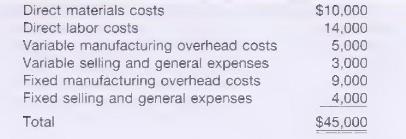1. The breakeven point is that point where: a. total sales revenue equals total variable and fixed...
Question:
1. The breakeven point is that point where:
a. total sales revenue equals total variable and fixed expenses.
b. total contribution margin equals total fixed expenses.
c. Both a and \(\mathrm{b}\) are correct.
d. Neither a nor b is correct.
2. Garth Company sells a single product that generates a positive contribution margin. If the selling price per unit and the variable cost per unit both increase \(10 \%\) and fixed costs do not change, the:

3. Honeybee Company's contribution margin ratio is \(60 \%\); the company's breakeven point in sales is \(\$ 150,000\). If the company wants to earn net income of \(\$ 60,000\) over the period, its sales would have to be:
a. \(\$ 200,000\).
b. \(\$ 350,000\).
c. \(\$ 250,000\).
d. \(\$ 210,000\).
4. Carlton Company sells its product for \(\$ 40\) per unit. The company's variable costs are \(\$ 22\) per unit; its fixed costs are \(\$ 82,800\) a year. Carlton's breakeven point is:
a. \(\$ 184,000\).
b. 3,764 units.
c. \(\$ 150,545\).
d. 2,070 units.
5. Fixed manufacturing overhead costs are allocated to each unit of product using:
a. the absorption-costing method only.
b. the variable-costing method only.
c. both the absorption- and variable-costing methods.
d. neither the absorption-nor the variable-costing method.
6. Last year Clarence Company sold 3,600 units at a price of \(\$ 50\) per unit. The company's variable cost per unit was \(\$ 15\); its fixed costs for the year were \(\$ 40,530\). If the company wants a profit of \(\$ 40,000\) next year, all other factors remaining constant, it will have to sell:
a. 1,158 units.
b. 1,958 units.
c. 2,300 units.
d. 800 units.
7. When production exceeds sales, absorption-costing net income generally:
a. is less than variable-costing net income.
b. is more than variable-costing net income.
c. equals variable-costing net income.
d. is higher or lower than variable-costing net income because no generalization can be made.
8. Last year, Bone Company produced 10,000 units of product \(\mathrm{X}\) and incurred the following costs:

Under absorption costing, any unsold units of product \(\mathrm{X}\) would be carried in Finished Goods Inventory at a unit cost of:
a. \(\$ 4.50\).
b. \(\$ 4.20\).
c. \(\$ 3.80\).
d. \(\$ 2.90\).
9. Selling and administrative expenses are:
a. a product cost under variable costing.
b. a product cost under absorption costing.
c. part of fixed manufacturing overhead under variable costing.
d. a period expense under both variable and absorption costing.
10. Last year Smith Company had net income of \(\$ 125,000\) using variable costing and \(\$ 105,000\) using absorption costing. The company's variable production costs were \(\$ 20\) per unit; its total fixed overhead was \(\$ 176,000\). The company produced 11,000 units. Production levels and fixed costs have not changed in three years. During the year, Smith's finished goods inventory:
a. increased by 1,000 units.
c. decreased by 1,000 units.
b. increased by 1,250 units.
d. decreased by 1,250 units.
Step by Step Answer:

Managerial Accounting Information For Decisions
ISBN: 9780324222432
4th Edition
Authors: Thomas L. Albright , Robert W. Ingram, John S. Hill





